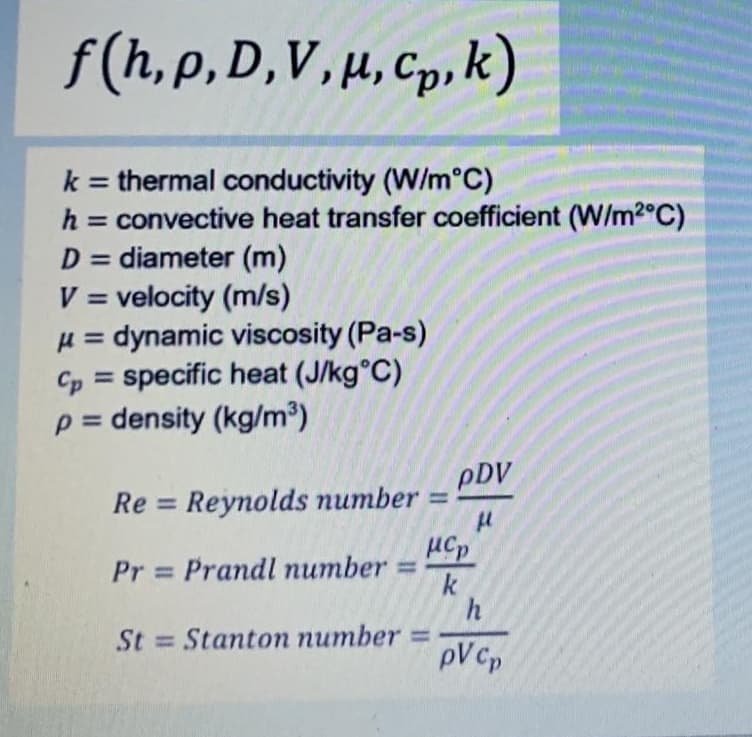f(h,p,D,V, µ, Cp, k) k = thermal conductivity (W/m°C) h = convective heat transfer coefficient (W/m2°C) D = diameter (m) V = velocity (m/s) H = dynamic viscosity (Pa-s) Cp = specific heat (J/kg°C) p = density (kg/m³) pDV Re = Reynolds number = %3D uCp Pr Prandl numbers k St = Stanton number pVc,
f(h,p,D,V, µ, Cp, k) k = thermal conductivity (W/m°C) h = convective heat transfer coefficient (W/m2°C) D = diameter (m) V = velocity (m/s) H = dynamic viscosity (Pa-s) Cp = specific heat (J/kg°C) p = density (kg/m³) pDV Re = Reynolds number = %3D uCp Pr Prandl numbers k St = Stanton number pVc,
Principles of Heat Transfer (Activate Learning with these NEW titles from Engineering!)
8th Edition
ISBN:9781305387102
Author:Kreith, Frank; Manglik, Raj M.
Publisher:Kreith, Frank; Manglik, Raj M.
Chapter6: Forced Convection Over Exterior Surfaces
Section: Chapter Questions
Problem 6.25P
Related questions
Question
Using Buckinghams Pi theorem, obtain the dimensionless parameters: Reynolds number, Prandtl number, and Stanton number from the function:

Transcribed Image Text:f (h, p, D,V, u, Cp,k)
k = thermal conductivity (W/m°C)
h = convective heat transfer coefficient (W/m2°C)
D = diameter (m)
V = velocity (m/s)
H = dynamic viscosity (Pa-s)
Cp = specific heat (J/kg°C)
p = density (kg/m³)
pDV
Re = Reynolds number =
uCp
Pr Prandl number
k
St = Stanton number =
pV cp
Expert Solution
This question has been solved!
Explore an expertly crafted, step-by-step solution for a thorough understanding of key concepts.
Step by step
Solved in 4 steps with 4 images

Knowledge Booster
Learn more about
Need a deep-dive on the concept behind this application? Look no further. Learn more about this topic, mechanical-engineering and related others by exploring similar questions and additional content below.Recommended textbooks for you

Principles of Heat Transfer (Activate Learning wi…
Mechanical Engineering
ISBN:
9781305387102
Author:
Kreith, Frank; Manglik, Raj M.
Publisher:
Cengage Learning

Principles of Heat Transfer (Activate Learning wi…
Mechanical Engineering
ISBN:
9781305387102
Author:
Kreith, Frank; Manglik, Raj M.
Publisher:
Cengage Learning